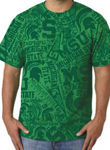 Stain Imaging is a versatile and cost-effective decorating technique to create customized t-shirt textures, patterns, and backgrounds. The specialty treatment was originally created by Tim Lunt, president of Stain Imaging, in the 1990s and has developed into an attractive alternative that shares some characteristics with well-known printing and dye techniques including jumbo screen printing, sublimation, direct-to-garment, tie dye, mineral washes, and more. Unlike traditional printing techniques, Stain Imaging has a softness and weathered or distressed look that naturally integrates the design into the garment. This specialty treatment is unique to Stain Imaging, as Lunt built the proprietary machines from the ground-up himself.
Stain Imaging is a versatile and cost-effective decorating technique to create customized t-shirt textures, patterns, and backgrounds. The specialty treatment was originally created by Tim Lunt, president of Stain Imaging, in the 1990s and has developed into an attractive alternative that shares some characteristics with well-known printing and dye techniques including jumbo screen printing, sublimation, direct-to-garment, tie dye, mineral washes, and more. Unlike traditional printing techniques, Stain Imaging has a softness and weathered or distressed look that naturally integrates the design into the garment. This specialty treatment is unique to Stain Imaging, as Lunt built the proprietary machines from the ground-up himself.
Stain Imaging is a great option for retailers looking to create a unique pattern, an alternative to traditional name-dropping, a one of a kind souvenir or gift item, to build their line of licensed teams or characters, or show support for a cause or organization. “We can really capture what you are all about,” says Lunt. Garments with Stain Imaging can also be treated with traditional screen-printing on top, for an even more customized finished product.
Retailers can supply their own choice of t-shirts to be printed. This means retailers can use the same suppliers they already work with and trust for quality garments. “With retailers providing the product, it helps them control their own cost,” explains Lunt. Stain Imaging simply takes those garments and adds value through the custom treatment. 100% cotton products are recommended, though the technique also works on most cotton and polyester blends.
Stain Imaging has an experienced art department that will work with you to engineer a unique pattern or theme. “We are here to support the design, layout, and presentation process at whatever level you need free of charge,” says Lunt. The treatment process ensures that no two shirts are exactly the same, resulting in a truly individual addition to your store. The minimum run is 144 shirts, which can be a combination of sizes, styles, and colors as long as they receive the same stain color. For more information, visit www.StainImaging.com.
